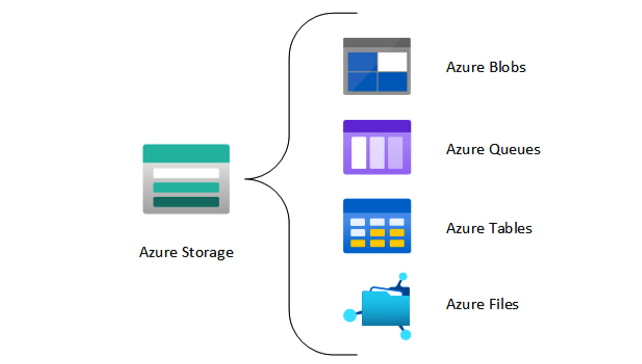Understanding Azure storage accounts
Azure offers a variety of services that can be utilized for storage; these can vary from database options to messaging systems, to files. Azure has identified four core types of services and integrated these into a single service named Azure Storage. These are identified as Azure Blobs, Azure Files, Azure Queues, and Azure Tables under an Azure storage account. A storage account may contain several data services in a combination of the ones described previously and stored collectively in a grouped service. Various types of data—such as files, documents, datasets, blobs, and virtual hard disks (VHDs)—can be stored in the storage account, and most will be accommodated by the defined structure. The following screenshot illustrates the different storage services associated with a storage account:

Figure 6.1 – Azure storage account services
Now that you have seen how storage services are provided within a storage account, we will explore the different types of storage accounts available to Azure.
Types of storage accounts
Azure Storage currently offers several different types of storage accounts, as detailed in this section. There are various components to consider when choosing the correct type of account, these being the following:
- Type of storage account (consider the service required)
- Redundancy
- Intended usage
- Performance
- Replication
- Security
- Limitations
Let’s now explore the different types of storage accounts.
General-purpose version 1 (legacy)
A general-purpose version 1 (GPv1) storage account is the oldest type of storage account. It offers storage for page blobs, block blobs, files, queues, and tables, but it is not always the most cost-effective storage account type. It is the only storage account type that can be used for the classic deployment model but does not support the latest features, such as access tiers. This account type is no longer recommended by Microsoft. It is still generally considered the cheapest of storage options but is highly restricted compared to general-purpose version 2 (GPv2) storage. Although legacy, these accounts can be upgraded to GPv2 storage. However, you should also consider storage costs as these might increase as a result of the change.
GPv2
This is a standardstorage account and supports blobs, queues, tables, and file shares. This is thestorage account type recommended for most scenarios. It supports locally redundant storage (LRS), geo-redundant storage (GRS), read-access GRS (RA-GRS), zone-redundant storage (ZRS), geo-ZRS (GZRS), and read-access GZRS (RA-GZRS)redundancy options.
Top Tip
v1 storage accounts can easily be upgraded to v2; however, be aware that an upgrade is permanent and cannot be rolled back. Follow this article for more information: https://docs.microsoft.com/en-us/azure/ storage/common/storage-account-upgrade?tabs=azure-portal.

